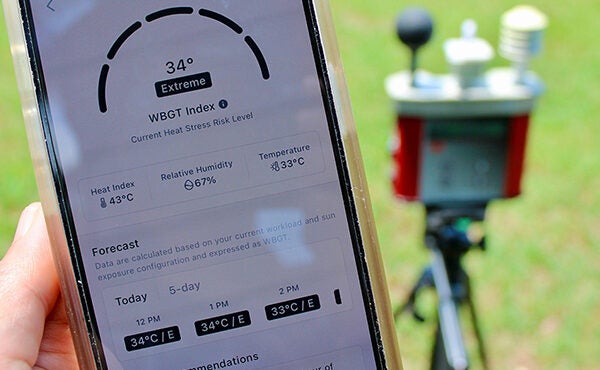ECU researchers guide heat stress app development
East Carolina University is acknowledged in the settings of an American Industrial Hygiene Association heat stress mobile app, which uses weather forecasts and emphasizes wet bulb globe temperature as the environmental heat metric to caution and protect outdoor workers in high-heat environments.
ECU faculty members Drs. Jo Anne Balanay and Sinan Sousan, joined by ECU director of licensing and commercialization Carlyle Rogers, have been instrumental in this advancement in collaboration with AIHA and software development company Dualboot Partners. The free app is in its beta version as AIHA is collecting feedback from users.
“It showed that our concept was working and we were able to make a good case with the AIHA that you could build your app based on our prototype,” said Balanay, professor in the ECU Department of Health Education and Promotion in the College of Health and Human Performance. “It is very rewarding, because I know it has been a long time for us to have this app become a reality. Having seen it and having AIHA be a partner and excited about it is great. Sometimes it still feels unreal for me, but the app is here and I’m very excited about it. Working with AIHA is such a joy, because I know they were the ones who could improve the app since they are experts on the industrial hygiene and occupational health fields.”
A motivation for Balanay and Sousan to focus on wet bulb globe temperature with app development is its use of myriad heat stress factors such as sun exposure, cloud cover and wind speed, in addition to temperature and humidity as contributors to determine heat index. Using WBGT calculations can provide more reliable heat exposure assessment data, which Balanay said is beneficial because underestimates of risks can happen when relying too much on heat index.

The American Industrial Hygiene Association heat stress app displays health recommendations in addition to heat stress risk level and heat index, humidity and wet bulb globe temperature data. (Photo by Jo Anne Balanay)
Another major component of the AIHA app is its forecasting function. The app pulls weather data from the National Weather Service based on the city or zip code inputted by the user, giving the app the ability to forecast WBGT.
This can assist in scheduling the most demanding outdoor tasks for workers each day.
“It’s giving the current WBGT, as well as the forecasted WBGT,” said Balanay, who added the app provides users with both WBGT and heat index data. “Forecasting is one thing that is not done by the traditional heat stress monitor, which just gives what it is measuring right now. The purpose of the forecasted WBGT is it can be used for planning. Supervisors, for example, they can plan ahead in terms of rescheduling work according to workload and WBGT.”
Dr. Sharon Paynter, ECU’s chief innovation and engagement officer, is proud of ECU’s role in technology that could directly impact outdoor workers and help prevent heat-related illnesses.
“Researchers and inventors at ECU are constantly working to address societal challenges through innovative solutions and technologies,” Paynter said. “This app will have particular relevance to laborers in agriculture, fishing, logging and other industries impacted by hazardous outdoor conditions.”
Sousan is an assistant professor in the ECU Department of Public Health. He has emphasized that technology and research at ECU continues toward making health risk assessments available and unique to individual workers.
“The new heat stress app is a step toward providing a better and more reliable heat stress assessment within the worker’s vicinity,” Sousan said. “It is also a starting point for future upgrades and the addition of real-time sensors to measure workers’ physiological data, eliminating any limitations.”
Balanay said the July launch of the app’s beta version “couldn’t be better timing,” given summer temperatures and heat advisories. Cloud cover is an included feature, giving app users the option to choose their outdoor sun exposure from sunny, mostly sunny, mostly cloudy, cloudy or full shade. This has a direct impact on measuring WBGT.
“I’m testing that option out to see how accurate it is compared to the heat stress monitors,” Balanay said. “I’ve been doing data collection at my home with a traditional instrument, testing it every 30 minutes. I’ll come out and if it’s cloudy, I’ll adjust the WBGT app into the cloudy setting and note that in comparison to what the traditional instrument would measure. The software developers helped us decide what features are best to include in the app and how they are best presented for users. In the end, we have an app that was much better than I had expected, and we are pleased to be involved.”